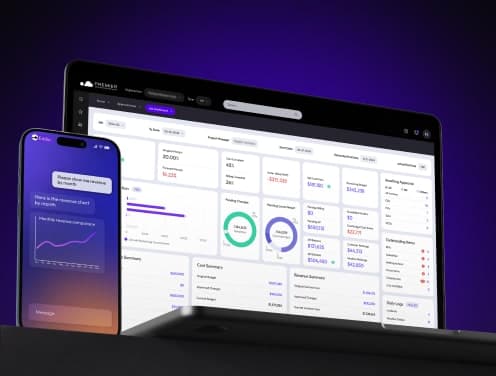
How to Finance a Construction Project Without Making Costly Mistakes
The U.S. construction industry is massive - it employs over 7 million people across nearly 700,000 companies. You're part of a booming sector where private construction spending hit almost $975 billion last year.
The path to financing construction projects brings its own set of challenges. Most lenders want you to put down 20-25% of your total project cost. Construction loans come with higher interest rates than traditional mortgages. These loans typically expire within a year, unlike conventional loans that can last decades.
The financial landscape gets trickier for contractors. Your payment cycles can drag on for weeks or months - and that's before counting retainage, which could take years. This makes managing cash flow especially challenging. Lenders often struggle to evaluate your creditworthiness because of this uncertain payment schedule.
A proper understanding of construction project financing is a vital part of your business success. You'll need careful planning, detailed documentation, and smart decision-making to secure contractor construction financing. Lenders want to see your business showing positive cash flow. You just need a complete strategy to get the funding your projects require.
This piece walks you through the essentials of construction financing - from different loan types to avoiding mistakes that can get pricey and derail your project. Let's create a strong financial foundation for your next construction venture!
Understand the Basics of Construction Financing
Construction financing works quite differently from traditional mortgages. You can save thousands of dollars and avoid getting pricey delays by learning these differences before securing your next project's funding.
What makes construction loans different
Several fundamental aspects set construction loans apart from standard mortgages. These loans finance building projects instead of existing property purchases. The biggest difference lies in how funds are distributed, lenders release money in phases called "draws" as construction moves forward, rather than giving you all the money upfront.
Lenders will inspect each draw to verify the work meets approved standards before releasing more funds. This staged funding helps them minimize risk since they can't use a completed structure as collateral.
The approval process also just needs more documentation. Lenders look at your financial qualifications and require:
- Project plans with timeline details
- Your builder's credentials and contract
- Detailed budget projections
- The completed property's estimated value
You'll typically make interest-only payments on the actual funds used during construction, not the full loan amount. Contractors managing multiple projects benefit from this interest-only structure since it improves cash flow during the building phase.
These loans come with higher interest rates than traditional mortgages because lenders face greater risks. Lenders offset their exposure through increased rates since they don't have an existing property as collateral.
Short-term vs. long-term financing explained
You'll find two main paths for construction financing: short-term construction-only loans or longer-term construction-to-permanent financing.
Construction-only loans usually last 6-12 months, enough time to finish your building project. You must pay off the balance or refinance into a permanent mortgage once construction ends. These loans give you flexibility but you'll need two separate loan processes with their own closing costs.
Construction-to-permanent loans (or "one-time close" loans) switch automatically to a traditional mortgage after construction. You'll get one approval, one closing, and one set of fees with these single-close loans. Many let you lock in your interest rate during approval, which protects you from market changes.
Traditional mortgages stretch 15-30 years with principal and interest payments starting right away. This differs significantly from construction loans where you mainly pay interest during building.
Your choice between short and long-term financing impacts your project significantly. Construction-only loans let you shop around for permanent financing terms later but leave you open to rate increases. You'll find construction-to-permanent loans simpler with potentially lower closing costs, though they might have tougher qualification requirements.
Contractors can use this knowledge to guide clients through funding or secure financing for their development projects. Your specific situation, timeline, and risk tolerance will determine the best choice.
Note that construction financing requirements vary among lenders. Some might ask for 20-30% down payments on construction loans versus 3-20% for traditional mortgages. You can find the best terms for your project by researching multiple financing sources.
Know the Types of Construction Loans Available
Your choice of construction loan can shape your project's financial future. Each option comes with unique benefits that match different needs and situations.
Construction-only loans
These loans cover just the building phase of your project. You'll need to repay these short-term loans that last 12-18 months after construction ends. The funds come through a series of draws linked to building milestones, and each draw needs inspection approval.
You'll pay interest only on the money you use during construction, not the full loan amount. This keeps your monthly payments lower while building, but you'll need to either pay cash or get a permanent mortgage once construction wraps up.
The best part? You get flexibility. Construction-only loans let you:
- Put down less money upfront
- Look for permanent financing terms later
- Change your long-term plans based on market conditions
In spite of that, you'll need to qualify for two separate loans and pay two sets of closing costs. The interest rates might also rise between when construction ends and you get permanent financing.
Construction-to-permanent loans
These loans give you short-term construction financing and long-term mortgage financing in one package. This "one-time close" or "single-close" option makes the process efficient.
The loan starts like a regular construction loan with draw schedules and inspections. After building finishes, it changes into a traditional mortgage that usually runs 15 to 30 years. Your payments then move from interest-only to principal-plus-interest.
You'll benefit from a simpler process with one application, one approval, and one closing. Many lenders also let you lock in your permanent mortgage rate when construction begins, which protects you from market changes. You'll save a lot on closing costs by avoiding duplicate fees.
What about the downsides? You'll need a higher credit score (usually 680+) and more money down (typically 20%) than other options. You'll also have fewer choices to shop for different permanent financing terms after construction.
Owner-builder loans
These specialized loans help people who want to be their own general contractors during construction. You can manage your project directly without hiring another contractor.
Lenders usually want to see professional building experience or a contractor's license. Most programs ask for credit scores of at least 725 and about 35% down payment of the total project cost. You'll need detailed construction plans and budgets that show you know the building process.
This is a big deal as it means that you can save money and keep creative control. You build equity right away by cutting out contractor markup fees. You retain control over picking subcontractors, choosing materials, and making design decisions.
The challenges? Lenders have stricter requirements because they see more risk. You'll spend more time on the project and take full responsibility for management. These loans work best if you have construction experience or know professionals in the industry.
Renovation loans
These loans fund improvements to existing properties instead of new construction. You can use them to pay for small updates or major structural changes.
Here are the main types:
- FHA 203(k) loans: Government-insured options with just 3.5% down
- HomeStyle loans: Fannie Mae-backed products that need only 3% down
- CHOICERenovation loans: Freddie Mac-supported financing that allows renovation costs up to 75% of the after-improvement value
Your borrowing power depends on the property's expected value after renovations, not its current worth. This gives you more funds to make high-impact improvements.
These loans are great if you want to buy fixer-uppers or update older properties. They combine purchase and improvement costs into one loan with one closing and one payment. Contractors and investors can use these products to finance flip projects or upgrade properties for sale or rent efficiently.
Estimate All Project Costs Before You Borrow
The foundations of successful construction financing rest on accurate cost estimation. You need a full picture of your project's actual costs before you approach lenders. This includes both obvious expenses and all potential financial requirements.
Hard costs vs. soft costs
Your construction budget has two basic expense categories that shape your financing needs differently. Hard costs represent the physical aspects of construction – everything you can see and touch. These usually take up about 70% of your total budget.
Hard costs include:
- Materials (concrete, lumber, steel, glass)
- Labor wages and subcontractor payments
- Equipment rentals and usage
- Interior and exterior finishes
- Mechanical systems (plumbing, electrical, HVAC)
- Safety systems and structures
Soft costs are vital yet invisible expenses that don't directly add to the physical building. These costs make up roughly 30% of your total budget and many people miss them in their initial estimates.
Soft costs cover:
- Architectural and engineering fees
- Permits and legal expenses
- Financing costs and interest payments
- Insurance and taxes
- Project management fees
- Administrative overhead
Project complexity, type, and size determine the exact split between hard and soft costs. To cite an instance, hospitals and schools often carry higher soft costs than office buildings due to their complex design needs.
Soft costs happen mainly during the predevelopment phase, before actual construction starts, while hard costs dominate the building phase. This timing difference impacts your cash flow planning and draw schedule – vital factors in your financing strategy.
Why contingency reserves matter
Construction projects rarely go exactly as planned. This reality makes contingency reserves essential to your financial stability.
A contingency reserve works like a financial safety net – extra money you set aside for unexpected costs or unforeseen events. These funds stay unallocated to any specific work area until needed.
Industry experts suggest setting aside 5-10% of your total budget for contingencies. This percentage might change based on project complexity and risk factors. High-risk elements like foundation work or remodeling projects might need larger contingency allowances.
Your contingency reserves might need to cover:
- Material price fluctuations
- Labor cost increases
- Weather-related delays
- Site condition surprises
- Design changes or omissions
- Additional permit requirements
A well-laid-out contingency reserve protects everyone involved – the owner, lender, and contractor. Without this buffer, unexpected cost overruns might force you to reduce your project scope, add more personal funds, or even stop construction.
Your contingency planning should go beyond just saving money. Your loan agreement needs clear guidelines about accessing contingency funds, required documentation, and who has approval authority. You should also specify what happens to unused contingency funds after project completion – these often go toward reducing the principal or get shared among project participants as incentives.
Lenders view thorough contingency planning favorably. It shows financial wisdom and realistic risk assessment – qualities that boost your loan application's strength.
Start by separating hard and soft costs, then add appropriate contingency reserves to your total budget before you talk to lenders. This all-encompassing approach helps secure enough funding while protecting your project from financial surprises.
Build a Strong Application to Secure Funding
A well-prepared loan application is the foundation for getting construction financing. Construction projects need a lot of capital. Knowing what lenders assess helps you create an application they're more likely to approve.
What lenders look for in a borrower
Lenders examine several factors in construction loan applications. Your credit score matters a lot - most lenders just need a minimum score of 620-680 for standard construction loans. Some banks ask for scores of 720 or higher for certain financing options.
Your financial health comes under the microscope next. Lenders check your debt-to-income (DTI) ratio to see if you can handle more debt. They'll also assess your cash reserves and overall liquidity.
You'll have to put down more money compared to regular mortgages. Plan to put down 20-25% of the total project cost upfront. Lenders ask for more because construction projects come with higher risks.
Lenders will also check out your chosen builder. They look at the builder's license, insurance, and success with similar projects. That's why teaming up with a reputable contractor who's been around makes your application stronger.
Building as your own general contractor? Get ready for tougher requirements. You'll have to show solid construction experience, maybe even a contractor's license and deep knowledge of building processes.
Documents you'll need to prepare
Construction loan applications need detailed documentation that goes beyond regular mortgage paperwork.
Here's the financial paperwork you'll need:
- Tax returns and W-2 forms from the past two years
- Recent pay stubs covering at least one month
- Bank statements from the previous two months
- Documentation of other income sources
- Current retirement and investment account statements
The construction-specific documents are just as crucial:
- Detailed construction plans and blueprints
- Detailed cost breakdown form
- Materials specification list
- Construction timeline with milestones
- Builder's contract with payment schedule
- Land documentation (deed or purchase agreement)
- Building permits and approvals
Builder's insurance proof, subcontractor details, and property appraisals make your application even stronger. Having these documents well-laid-out before you talk to lenders shows you mean business.
How to present your project plan
The way you present your project plan could make all the difference. Start by creating what pros call a "blue book", a detailed document that covers every part of your construction project.
Your blue book should have:
- Detailed project timeline with major milestones
- Complete budget breakdown (both hard and soft costs)
- Floor plans and architectural drawings
- Material specifications and quality levels
- Builder qualifications and past project examples
Make your budget clear and detailed. Split costs into categories, show your contingency reserves, and explain your big expenses. This shows lenders you've thought over all the money matters.
The draw schedule, your plan for accessing funds during construction, needs to line up with your timeline. A well-laid-out draw schedule shows you're good at financial planning.
Be ready to tell lenders why your project works and how you'll handle challenges. They like borrowers who plan ahead and have backup plans ready.
Think about talking to different lenders who know construction loans inside out. Not everyone offers construction financing, and specialists are a great way to get guidance throughout the process. Ask how many construction loans they've handled recently and if they have dedicated construction loan officers.
A detailed, well-organized application that tackles all lender concerns upfront gives you the best shot at getting approved with good terms.
Choose the Right Financing Option for Your Project
The right financing source for your construction project could mean the difference between profit and loss. Several options exist, and you need to match their benefits to your specific situation.
Bank loans vs. private lenders
Traditional bank loans come with lower interest rates than private lenders, making them attractive to anyone needing long-term financing. Banks have stricter qualification processes that leave many contractors frustrated.
Here are the main differences between bank loans and private lenders:
- Approval Speed: Banks need at least a month to approve construction loans. Private lenders close deals in two to four weeks. Some private lenders might even get you funding in just a week.
- Documentation Requirements: Private lenders keep things simple with documentation. They ask for credit checks, experience verification, liquidity verification, approved plans, third-party reports, and budget feasibility studies. Banks want extensive paperwork and detailed income documentation.
- Eligibility Criteria: Banks put heavy emphasis on Debt Service Coverage Ratio (DSCR), looking for at least 1.25x. Private lenders care more about property value and project potential than your financial history.
- Down Payment: You'll need 15-20% down with private lenders, while regional banks might ask for 40-50%.
Private lending works best if you need quick funding, don't meet bank requirements, have a short-term investment plan, or need flexible underwriting. Banks remain your best bet if you can wait for approval, meet DSCR requirements, and want long-term financing with lower interest rates.
SBA or government programs might be your answer
SBA loans bridge the gap between strict bank requirements and private lender flexibility. The SBA 7(a) Loan Program helps small businesses with special requirements get loan guaranties.
These loans can help you:
- Buy, refinance, or improve real estate and buildings
- Purchase machinery and equipment
- Change ownership
- Get working capital
SBA loans max out at $5 million with down payments as low as 10%, opening doors for projects that might not qualify for regular financing.
SBA financing might work for you if:
- Your business fits SBA size requirements
- You'll use at least 60% of new construction
- You want long-term financing (up to 25 years for real estate)
- You can show good character and management skills
The SBA works through participating lenders who help find the right program for your needs - they don't lend directly.
Trade credit and lines of credit
Two more financing tools can help manage your construction cash flow: trade credit and lines of credit.
Trade credit lets you delay payment for building materials, working like an interest-free loan from suppliers. Most suppliers give you 30 days or more before charging interest or late fees. This setup helps you make bigger purchases and grow your business without immediate cash.
Construction lines of credit let you access funds whenever needed for any business expense. The best part? Interest applies only to what you borrow, not your total credit limit.
Lines of credit come in two types:
- Secured: You back it with collateral like real estate or equipment
- Unsecured: No collateral needed, but harder to qualify for
Lines of credit help smooth out cash flow, bridge payment gaps between projects, boost purchasing power, and cover daily expenses while waiting for client payments. Interest rates range from 8% to 60% based on your financial background, so shop around for good terms.
New construction borrowers often succeed by mixing these financing methods. You might get your main funding through a bank or SBA loan while keeping a line of credit for flexibility and using trade credit for materials.
Avoid Common Mistakes That Lead to Cost Overruns
Cost overruns can quickly derail even well-laid-out construction projects. Most builders don't realize they're heading for trouble until it's too late. Only when we are willing to spot and avoid these common pitfalls can you protect your project's budget and timeline from unnecessary setbacks.
Underestimating costs
Most builders underestimate their funding needs by 15-20%. These dangerous cash flow gaps can halt progress mid-project. This miscalculation often happens because original budgets don't account for ground variables that inevitably affect construction.
Several factors lead to cost underestimation:
- Material price volatility - Lumber and steel prices can swing by 20-30% over a six-month build
- Labor market fluctuations - Skilled trade shortages can push subcontractor costs 15-25% above estimates
- Permit and inspection delays - Municipal backlogs add 4-8 weeks to timelines, increasing carrying costs
- Weather-related setbacks - Seasonal delays often push completion dates beyond financing lock periods
Experienced builders set aside contingency reserves equal to 10% of total costs to cover unexpected expenses. Without this buffer, you'll face financing gaps at the worst possible times.
Ignoring draw schedules
Your draw schedule determines whether your build maintains steady progress or stalls due to funding gaps. Construction loans work best when funds release at verified milestones. Poorly managed requests create cascading delays that add weeks to your timeline.
Common draw schedule mistakes include:
- Incomplete draw requests - Missing line items or unclear descriptions of completed work delay inspection approval
- Poor timing of requests - Submitting requests too close to upcoming payables creates short-term funding gaps
- Communication gaps - Missed calls or unanswered emails are common causes of funding delays
Delayed draws might force you to bridge gaps with expensive short-term financing options. A current draw schedule that matches your project timeline and budget prevents this. This careful matching helps you manage the financial flow without overruns or shortfalls.
Skipping builder vetting
Your choice of partners dramatically affects your project's success. Construction businesses have nearly a 65% chance of failing within their first five years, making them the riskiest industry to partner with. Rushing through the vetting process gambles your project's success on these odds.
Professional construction companies never leave subcontractor selection to one person's judgment. A multi-person approval process should include:
- Project management to assess timeline
- Financial management to evaluate costs
- Safety management to verify risks and compliance
- Quality control to review technical capability
Time spent on proper due diligence saves months of delays, legal battles, and financial losses. Poor contractor selection threatens your timeline and can blow your budget with rework, disputes, and quality issues.
Your financing partner determines if your build moves quickly or stalls with delays costing thousands daily. Careful planning around these three common pitfalls increases your chances of completing your project on time and within budget.
Use Technology to Track and Control Spending
Technology is reshaping how construction spending gets tracked and controlled. Digital tools help you spot budget issues before they get pricey.
How Premier helps with live cost tracking
Premier's construction project management system tackles major financial challenges through automated approval workflows for invoicing, RFIs, purchase orders, and subcontracts. Users who switched from server-based software reduced their clicks by 80% to complete tasks.
The construction finance management platform lets you monitor labor, materials, and overhead expenses as they occur. Project managers can pull up detailed reports quickly, track pending subcontracts, and check accounts payable status. This clear view helps them make smart decisions about cash flow and project performance.
Premier stands out with these practical cost control features:
- Custom cost thresholds with automated alerts that catch potential overruns before they hurt your bottom line
- Live forecasting that updates your Estimate at Completion (EAC) using project data automatically
- Month-to-month variance analysis that lets you dig deep into specific line items
Project managers can adjust budgets ahead of time and move financial resources where they matter most.
Benefits of cloud-based construction ERP systems
Cloud-based construction ERP systems are a great way to finance projects. They remove the need for expensive internal IT infrastructure. This frees up money for core construction work.
The real value comes from complete data integration. Cloud ERPs sync job costing with your general ledger and update both systems with each transaction. This creates one reliable source for all project finances.
These systems do more than save money directly. They give detailed financial insights that boost your credibility with lenders. WIP reports are generated easily, which cuts down manual calculations and possible errors. You get full visibility into project performance through 35+ custom reports covering budgets, actuals, forecasts, and margins.
Construction takes up about 70% of an organization's capital improvement budget. This makes strong cost management systems crucial. Companies using advanced digital solutions have saved substantial amounts - one saved $70 million from active projects.
Making use of these tech tools throughout your construction financing process gives you better budget control. It also builds trust with lenders through detailed, accurate financial reports.
Plan for the Transition After Construction Ends
Financial planning doesn't end when your construction project finishes, it marks the beginning of your long-term financial stability.
Refinancing into a mortgage
Your construction loan moves to permanent financing after project completion. You'll need to shop for a mortgage to pay off your short-term debt with construction-only loans. Construction-to-permanent loans convert automatically to a traditional mortgage when the project is done. Your monthly payments will move from interest-only to principal-plus-interest after this conversion. A $400,000 loan at 7% interest over 30 years typically requires payments around $2,129.
Meeting stabilization requirements
Lenders need stabilization metrics to verify your project's viability before they finalize permanent financing. Most lenders need a certificate of occupancy for all residential units. Fannie Mae's Near-Stabilization program needs 75% physical occupancy at rate lock. Freddie Mac's Lease-Up program allows financing at just 50% occupancy. So your choice between programs should align with your leasing timeline and market conditions.
Preparing for long-term repayment
Schedule a final inspection to get your certificate of occupancy right after construction ends. An appraisal will determine your property's value for permanent financing. Timing is significant, construction delays can lead to extension fees or higher interest rates. You need to maintain clear communication with builders and lenders to ensure a smooth transition to your long-term financial arrangement.
Conclusion
Building a construction project requires careful planning, solid research, and smart decisions about financing. Construction loans work differently than traditional mortgages. Understanding your options helps you pick the right financing solution that fits your needs. A successful project funding depends on accurate cost estimates that cover both hard and soft costs with enough contingency reserves.
Your chances of loan approval largely depend on how strong your application is. You should prepare detailed documentation, keep your credit score high and create a clear project plan. Finding the right financing partner is vital - it could be a traditional bank, private lender, or government program based on your timeline, money situation, and project details.
Projects need more than just original funding to succeed. You must watch out for budget problems like underestimating costs, issues with draw schedules, and picking the wrong contractors. Technology is a significant factor here - Premier Construction Software's live cost tracking helps you catch potential problems before they drain your money.
The end of construction brings its own challenges. You need to focus on stabilization requirements and long-term repayment plans for permanent financing. Construction financing might look complex at first, but you can build strong financial foundations with proper preparation and the right tools.
Note that your financing choices affect both your current project and your company's future financial health. Take time to explore options and ask financial professionals when needed. Choose solutions that line up with your current needs and future goals. Smart planning and careful execution will set your construction projects up for financial success from start to finish.





















